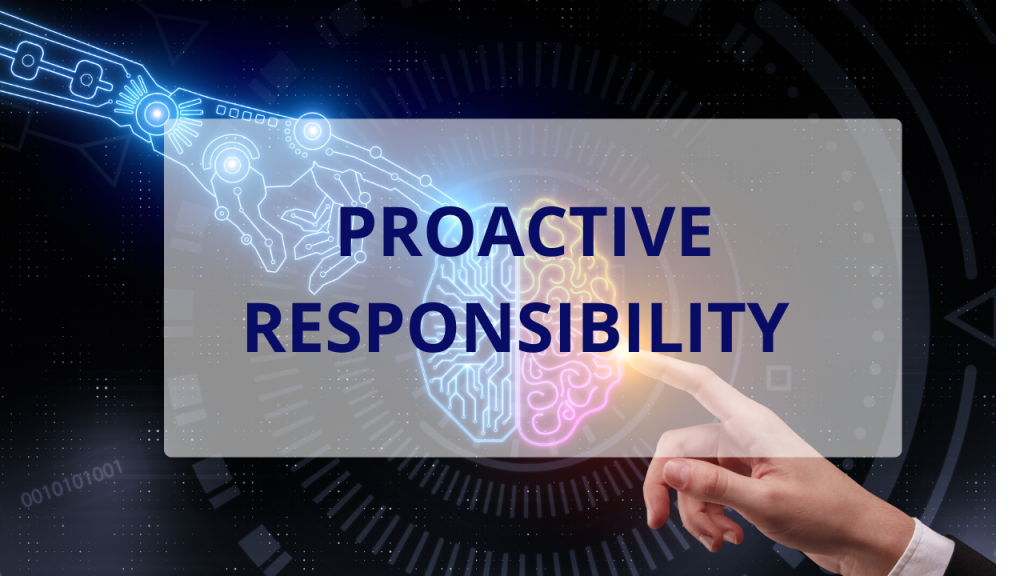
Proactive Responsibility in AI Product Management: Integrating Legal and Ethical Narratives
Why Responsibility in AI Product Management Matters Now?
Artificial Intelligence is no longer an experimental edge case—it is now embedded in products that shape decisions, behaviors, and markets at scale. From content moderation to facial recognition, from workplace automation to generative tools, the stakes are no longer theoretical. The EU AI Act, the White House’s AI Bill of Rights, and high-profile debates over bias and accountability make one thing clear: responsibility in AI is not optional – it’s structural.
And yet, most conversations about responsible AI still hover at the level of principles and policies. What’s often missing is a translation into day-to-day product management: how teams actually define outcomes, set priorities, and ship features. This is the critical gap. Product managers sit at the crossroads of strategy, design, engineering, and governance. It is here—within the messy, iterative work of product development—that ethical and legal narratives must be embedded if AI systems are to be truly trustworthy.
From Projects to Products: Why the Shift Matters in AI
Traditional IT development has long been dominated by the waterfall project model: a sequence of requirements, plans, and deliverables that move linearly toward completion. But AI doesn’t fit this paradigm. Machine learning systems adapt over time, require constant monitoring, and often behave in unpredictable ways once deployed. Treating AI as a one-off “project” is like trying to lock down a moving target. That’s why the product model has become essential. Instead of chasing completion, product management focuses on continuous delivery, iteration, and outcome measurement. This model is particularly critical in AI, where responsibility cannot be retrofitted. Responsible practices must evolve alongside the product itself, responding to new behaviors, feedback, and regulatory expectations. Here, Outcome-Driven Product Management (ODPM) provides the anchor. Unlike output-driven approaches (ship more features, faster), ODPM asks: what change are we trying to drive – in users, in organizations, and in society? For AI, this shift is not just semantic. It means treating ethical and legal outcomes as core success metrics, on par with business and technical goals.
Beyond Outputs: The Core of Outcome-Driven Product Management
In AI development, it’s easy to measure progress by outputs: number of features shipped, lines of code written, or models deployed. But outputs can be deceptive. A powerful feature released without considering its downstream effects can generate adoption—and simultaneously amplify bias, privacy risks, or unintended harms.
Outcome-Driven Product Management shifts the lens from what we build to what actually changes. Outcomes are about the real-world behaviors, decisions, and structures that AI systems shape. In practice, this means:
- For users: Are decisions more transparent, fair, and understandable?
- For organizations: Are processes more accountable, not just more efficient?
- For society: Does the product reinforce or reduce inequities, risks, and systemic harms?
In AI, outcomes must therefore be multi-layered – commercial, technical, ethical, and legal. A recommendation engine that increases engagement but spreads disinformation cannot be called a success. Similarly, a biometric system that reduces fraud but undermines civil rights cannot be treated as a win. For product managers, ODPM provides both a strategic compass and an ethical filter. Every roadmap decision, design trade-off, or sprint priority should be interrogated through outcomes, not just outputs. It is in these micro-decisions—where efficiency pressures meet ethical uncertainty—that responsibility is either embedded or lost.
Proactive Responsibility: Embedding Ethics & Law from the Start
Too often, responsibility in AI is treated as an afterthought — a checklist at the end of development or a compliance review before launch. By then, most critical design choices are already locked in, and ethical concerns are harder (and costlier) to resolve. A more sustainable approach is proactive responsibility: embedding ethical and legal considerations from the outset and treating them as integral to product design, not external constraints. This means that product managers don’t wait for regulation to dictate the boundaries — they anticipate risks, surface interdependencies, and question blind spots during discovery, planning, and iteration. This proactive stance changes the role of collaboration. Legal and ethical experts should not appear only at the sign-off stage. They need to sit alongside engineers, designers, and product teams—helping shape roadmaps, framing trade-offs, and informing backlog prioritization. In practice, this can mean:
- Running pre-mortems on ethical and legal risks before features are built.
- Embedding “responsibility tags” in user stories or tickets to capture potential risks.
- Using ethics boards or review rituals within sprint cycles, not outside them.
By reframing ethics and law as design inputs, not compliance gates, product teams create AI systems that are not only innovative but also trustworthy. And critically, this proactive approach doesn’t just protect organizations from risk – it positions them ahead of regulation, shaping the standards others will follow.
Engaging the Right Stakeholders, the Right Way
Building responsible AI products is not something product teams can solve in isolation. The complexity of AI – its technical opacity, its social impacts, its legal uncertainties – means that broad and intentional stakeholder engagement is essential. But it’s not just about “involving everyone.” It’s about engaging the right people, at the right time, in the right way.
Key groups include:
- End-users and affected communities – to surface unintended harms, usability gaps, or inequities that teams may overlook.
- Developers and data scientists – to flag technical limitations and monitor model behavior in real-world contexts.
- Ethical and legal experts – to connect product decisions with regulatory and societal expectations.
- Policymakers and regulators – to inform governance debates with ground-level insights and anticipate compliance shifts.
- Business leaders – to ensure responsibility aligns with strategy and resource allocation.
What matters is not just who is included, but how. Effective engagement requires formats that foster candor and balance power dynamics, such as:
- Co-design sessions with users and civil society groups.
- Sprint ethics boards embedded in agile rituals.
- Participatory workshops where engineers, product managers, and legal experts stress-test assumptions together.
Done well, stakeholder engagement creates two-way benefits: better, safer products for companies, and richer, more practical insights for policymakers and regulators. Done poorly, it risks tokenism or box-ticking. For product managers, the challenge is to build authentic, ongoing engagement mechanisms—not just annual consultations.
Best Practices for Responsible AI Product Management
Turning responsibility into practice requires more than good intentions. It calls for repeatable practices and structures that teams can apply across the product lifecycle. Five pillars stand out:
1. Embed Ethical & Legal Frameworks Early
Don’t bolt on responsibility at the end. Use approaches like Value-Sensitive Design or Ethics Canvas to integrate principles of fairness, transparency, and privacy from the discovery phase onward. Map your features against the EU AI Act or IEEE standards so legal compliance and ethical foresight become natural parts of the roadmap.
2. Prioritize Outcomes, Not Just Outputs
Ask: what real-world behaviors and system-level effects are we shaping? A model that boosts engagement but spreads disinformation is not a win. ODPM reframes success as measurable business, ethical, and legal outcomes—not just velocity or feature counts.
3. Build Accountability Frameworks
Accountability cannot rest on individuals alone. Formalize it with practices such as ethics tags in backlog items, model cards, and bias audit checkpoints. These structures keep responsibility visible and shared across the team.
4. Institutionalize Continuous Discovery
AI products evolve after launch. Responsibility must evolve with them. Use feedback loops (from users, auditors, regulators) to refine outcomes continuously. Treat ethical discovery the way you treat customer discovery: an iterative, ongoing process, not a one-time study.
5. Invest in Training & Culture
Ethics is a skillset, not just a mindset. Train product managers, engineers, and leaders on how AI risks manifest and how to mitigate them. Appoint product coaches or ethical leads who reinforce responsible practices in daily work, so responsibility becomes a competence woven into culture, not a special project.
A Blueprint for Trustworthy AI Products
Responsible AI cannot be achieved through regulation alone, nor left to ethics boards detached from product realities. It must be embedded where decisions are made daily: in product management. By shifting from projects to products, from outputs to outcomes, and from reactive compliance to proactive responsibility, product managers can shape AI systems that are both innovative and trustworthy.
This blueprint is not abstract—it is actionable. It calls on product managers to:
- Frame outcomes that include ethical and legal criteria, not just commercial ones.
- Embed responsibility into roadmaps, rituals, and backlogs.
- Engage stakeholders in ways that are authentic and power-aware.
- Iterate continuously, so responsibility evolves alongside technology.
The opportunity is clear: organizations that embrace responsibility early won’t just comply with the EU AI Act or future regulations—they will differentiate themselves as leaders in trust, governance, and societal alignment. In a landscape where trust is the ultimate currency, responsible AI product management is not a cost—it’s a competitive advantage.
The question for product leaders, then, is not whether responsibility fits into product management, but how quickly they will make it their operating norm. Because the future of AI will not be defined by principles on paper, but by the choices made in product backlogs, sprint reviews, and strategy rooms.
